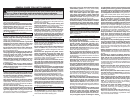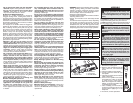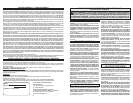
4
5
FUNCTIONAL DESCRIPTION
SYMBOLOGY
SPECIFICATIONS
Cat. No.
Volts
DC No load RPM Collet
Max.
Accessory
Diameter
2460-20 12 5000 - 32000 1/8" * 2"
ASSEMBLY
WARNING Recharge only with the
charger specifi ed for the battery. For
specifi c charging instructions, read the opera-
tor’s manual supplied with your charger and
battery.
1. Collet nut
2. Spindle lock
Inserting/Removing the Battery
To remove the battery, push in the release buttons
and pull the battery pack away from the tool.
To insert the battery, slide the pack into the body of
the tool. Make sure it latches securely into place.
* accepts standard collet sizes 1/32", 1/16", 3/32", 1/8"
Direct Current
Underwriters Laboratories, Inc.
United States and Canada
No Load Revolutions per
Minute (RPM)
2
5
3
4
3. Speed dial
4. Fuel gauge
5. On/Off switch
• Do not operate the power tool near fl ammable
materials. Sparks could ignite these materials.
• Do not use accessories that require liquid
coolants. Using water or other liquid coolants
may result in electrocution or shock.
Kickback and Related Warnings
Kickback is a sudden reaction to a pinched or
snagged rotating wheel, sanding band, brush or
any other accessory. Pinching or snagging causes
rapid stalling of the rotating accessory which in turn
causes the uncontrolled power tool to be forced in
the direction opposite of the accessory’s rotation
at the point of the binding.
For example, if an abrasive wheel is snagged or
pinched by the workpiece, the edge of the wheel
that is entering into the pinch point can dig into
the surface of the material causing the wheel to
climb out or kick out. The wheel may either jump
toward or away from the operator, depending on
direction of the wheel’s movement at the point of
pinching. Abrasive wheels may also break under
these conditions. Kickback is the result of power
tool misuse and/or incorrect operating procedures
or conditions and can be avoided by taking proper
precautions as given below.
• Maintain a fi rm grip on the power tool and
position your body and arm to allow you to
resist kickback forces. The operator can control
kickback forces, if proper precautions are taken.
• Use special care when working corners, sharp
edges etc. Avoid bouncing and snagging the
accessory. Corners, sharp edges or bouncing
have a tendency to snag the rotating accessory
and cause loss of control or kickback.
• Do not attach a thin toothed saw blade. Such
blades create frequent kickback and loss of control.
• Always feed the bit into the material in the
same direction as the cutting edge is exiting
from the material (which is the same direction
as the chips are thrown). Feeding the tool in the
wrong direction causes the cutting edge of the bit
to climb out of the work and pull the tool in the
direction of this feed.
• When using steel saws, cut-off wheels, high-
speed cutters or tungsten carbide cutters,
always have the work securely clamped. These
wheels will grab if they become slightly canted
in the groove, and can kickback. When a cut-off
wheel grabs, the wheel itself usually breaks. When
the steel saw, high-speed cutters or tungsten
carbide cutter grab, it may jump from the groove
and you could lose control of the tool.
Safety Warnings Specific for Grinding and
Abrasive Cutting-Off Operations:
• Use only wheel types that are recommended
for your power tool and only for recommended
applications. For example: do not grind with
the side of a cut-off wheel. Abrasive cut-off
wheels are intended for peripheral grinding, side
forces applied to these wheels may cause them
to shatter.
• For threaded abrasive cones and plugs use
only undamaged wheel mandrels with an
unrelieved shoulder fl ange that are of correct
size and length. Proper mandrels will reduce the
possibility of breakage.
• Do not “jam” a cut-off wheel or apply excessive
pressure. Do not attempt to make an excessive
depth of cut. Overstressing the wheel increases
the loading and susceptibility to twisting or bind-
ing of the wheel in the cut and the possibility of
kickback or wheel breakage.
• Do not position your hand in line with and
behind the rotating wheel. When the wheel, at
the point of operation, is moving away from your
hand, the possible kickback may propel the spin-
ning wheel and the power tool directly at you.
• When wheel is binding or when interrupting a
cut for any reason, switch off the power tool
and hold the power tool motionless until the
wheel comes to a complete stop. Never attempt
to remove the cut-off wheel from the cut while
the wheel is in motion otherwise kickback may
occur. Investigate and take corrective action to
eliminate the cause of wheel binding.
• Do not restart the cutting operation in the
workpiece. Let the wheel reach full speed and
carefully reenter the cut. The wheel may bind,
walk up or kickback if the power tool is restarted
in the workpiece.
• Support panels or any oversized workpiece to
minimize the risk of wheel pinching and kick-
back. Large workpieces tend to sag under their
own weight. Supports must be placed under the
workpiece near the line of cut and near the edge
of the workpiece on both sides of the wheel.
• Use extra caution when making a “pocket cut”
into existing walls or other blind areas. The pro-
truding wheel may cut gas or water pipes, electrical
wiring or objects that can cause kickback.
Safety Warnings Specifi c for Wire Brushing
Operations:
• Be aware that wire bristles are thrown by the
brush even during ordinary operation. Do not
overstress the wires by applying excessive
load to the brush. The wire bristles can easily
penetrate light clothing and/or skin.
• Allow brushes to run at operating speed for
at least one minute before using them. During
this time no one is to stand in front or in line
with the brush. Loose bristles or wires will be
discharged during the run-in time.
• Direct the discharge of the spinning wire
brush away from you. Small particles and tiny
wire fragments may be discharged at high velocity
during the use of these brushes and may become
imbedded in your skin.
Additional Safety Warnings
•
Maintain labels and nameplates. These carry
important information. If unreadable or missing,
contact a MILWAUKEE service facility for a free
replacement.
• WARNING: Some dust created by power sanding,
sawing, grinding, drilling, and other construction
activities contains chemicals known to cause
cancer, birth defects or other reproductive harm.
Some examples of these chemicals are:
• lead from lead-based paint
• crystalline silica from bricks and cement and other
masonry products, and
• arsenic and chromium from chemically-treated
lumber.
Your risk from these exposures varies, depending
on how often you do this type of work. To reduce
your exposure to these chemicals: work in a well
ventilated area, and work with approved safety
equipment, such as those dust masks that are spe-
cially designed to fi lter out microscopic particles.
WARNING Always remove battery
pack before changing or removing ac-
cessories. Only use accessories specifi cally
recommended for this tool. Others may be
hazardous.
Installing Accessories
1. Remove the battery pack.
2. Remove dust and debris from the
collet, collet nut, and accessory
shank.
3. Insert the collet into the spindle.
4. Loosely screw the collet nut onto
the spindle.
5. Insert the accessory shank into the
collet at least 3/4".
6. Press in the spindle lock button
and tighten the collet nut secure-
ly using the 3/8" collet wrench.
Note: Do not tighten the collet nut
without an accessory installed. This
could damage the collet.
7. Insert a battery pack and test the
accessory by letting it spin for one
minute before applying it to the
workpiece.
8. To remove, reverse procedure.
WARNING To reduce the risk of injury,
always clean mandrels before inserting
them into the collet and securely tighten the
collet nut and. Otherwise the high-speed rota-
tion of the tool could force the accessory to
fl y out of the collet.
WARNING Only use accessories with
Maximum Safe Operating Speed rated
at least equal to the maximum speed marked
on the power tool. This speed is based on the
strength of the accessory, allowing for a reason-
able measure of safety. It is not meant to imply
a best or most effi cient operating speed. Do not
exceed the Maximum Safe Operating Speed.
WARNING Everyone in the area must
wear protective clothing and safety
goggles or face shields. Damaged acces-
sories may fl y apart with considerable force,
causing potential for serious injury.
1















